
Concept explainers
Recording Transactions (in a Journal and T-Accounts); Preparing and Interpreting the
Ethan Allen Interiors Inc. is a leading manufacturer and retailer of home furnishings in the United States and abroad. The following is adapted from Ethan Allen’s September 30, 2016,

Assume that the following events occurred in the following quarter.
- a. Paid $30 cash for additional inventory.
- b. Issued additional shares of common stock for $20 in cash.
- c. Purchased equipment for $170; paid $60 in cash and signed a note to pay the remaining $110 in two years.
- d. Signed a short-term note to borrow $10 cash.
- e. Conducted negotiations to purchase a sawmill, which is expected to cost $36.
Required:
- 1. Calculate Ethan Allen’s
current ratio at September 30, 2016, prior to the transactions listed above. Based on this calculation and the analysis of TripAdvisor’s current ratio in the chapter, indicate which company is in a better position to pay liabilities as they come due in the next year. - 2. Analyze transactions (a)–(e) to determine their effects on the
accounting equation. Use the format shown in the demonstration case. - 3. Record the transaction effects determined in requirement 2 using journal entries.
- 4. Using the September 30, 2016, ending balances as the beginning balances for the October–December 2016 quarter, summarize the
journal entry effects from requirement 3. Use T-accounts if this requirement is being completed manually; if you are using the general ledger tool in Connect, the journal entries will have been posted automatically to general ledger accounts that are similar in appearance to Exhibit 2.9. - 5. Explain your response to event (e).
- 6. Prepare a classified balance sheet at December 31, 2016.
- 7. Use your response to requirement 6 to calculate Ethan Allen’s current ratio after the transactions listed in (a)–(e). Based on this calculation and the calculation in requirement 1, indicate whether the above transactions increase or decrease the company’s ability to pay current liabilities as they come due in the next year.
- 8. As of December 31, 2016, has the financing for Ethan Allen’s investment in assets primarily come from liabilities or stockholders’ equity?
1.
Ascertain the current ratio of Company E at September 30, 2016 and compare the current ratio of Company E with current ratio of Company T.
Explanation of Solution
Current Ratio: A part of liquidity ratios, current ratio reflects the ability to oblige the short term debts of a company. It is calculated based on the current assets and current liabilities; a company has in an accounting period. A current ratio is a useful tool for analysis of financials of a company.
Calculate the current ratio of Company E at September 30, 2016 as follows:
Here,
Current assets = $273 millions
Current liabilities= $135 millions
Therefore, the current ratio of Company E is 2.02.
Current ratio of Company E is 2.02 and Company T is 2.15, so Company E has less current ratio than Company T and this indicates that Company T has better position to repay the liabilities than Company E.
2.
Analyze the given transaction, and explain their effect on the accounting equation.
Explanation of Solution
Accounting equation: Accounting equation is an accounting tool expressed in the form of equation, by creating a relationship between the resources or assets of a company, and claims on the resources by the creditors and the owners. Accounting equation is expressed as shown below:
Accounting equation for each transaction is as follows:
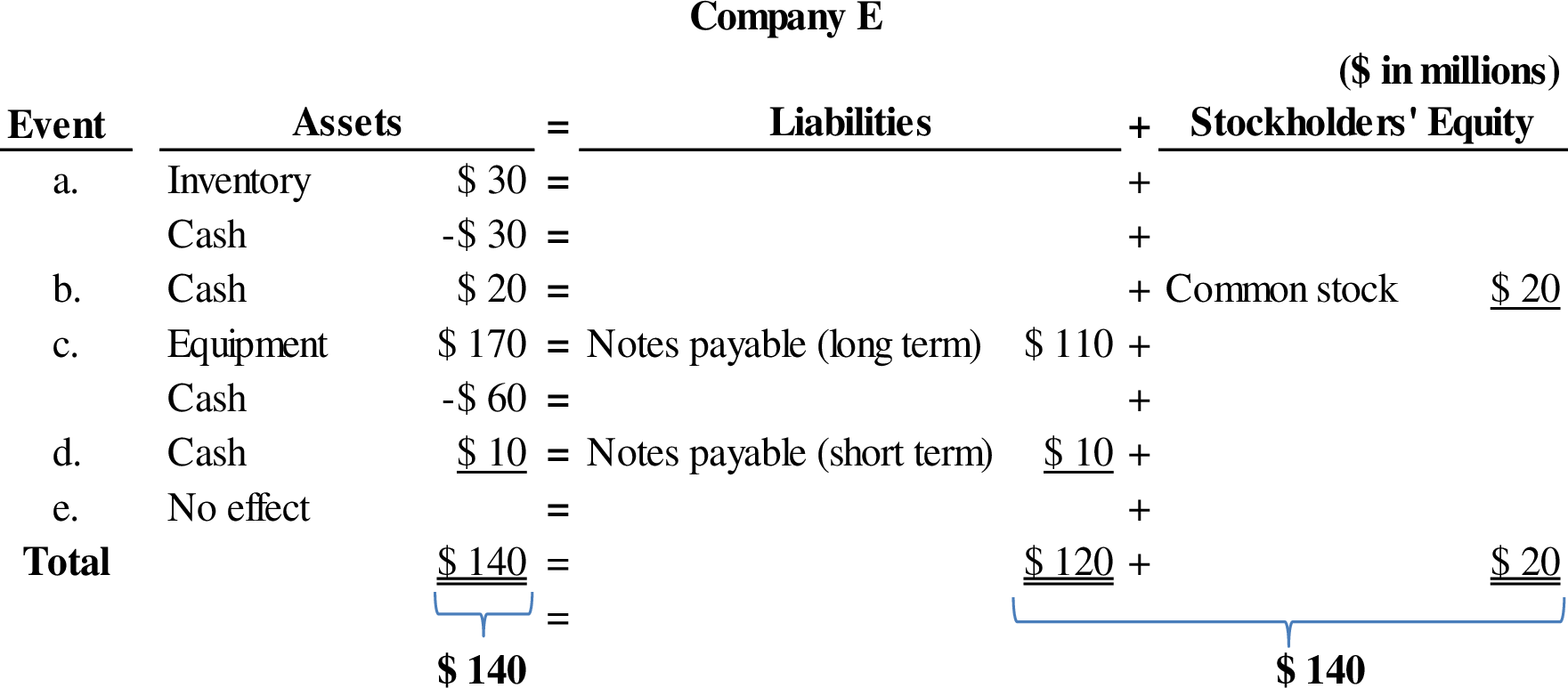
Figure (1)
Therefore, the total assets are equal to the liabilities and stockholder’s equity.
3.
Record the journal entries based on requirement 2.
Explanation of Solution
Journal: Journal is the method of recording monetary business transactions in chronological order. It records the debit and credit aspects of each transaction to abide by the double-entry system.
Rules of Debit and Credit:
Following rules are followed for debiting and crediting different accounts while they occur in business transactions:
- Debit, all increase in assets, expenses and dividends, all decrease in liabilities, revenues and stockholders’ equities.
- Credit, all increase in liabilities, revenues, and stockholders’ equities, all decrease in assets, and expenses.
Journal entries of Company E are as follows ($ in millions):
a. Inventories purchased in cash:
| Date | Accounts title and explanation | Ref. | Debit ($) | Credit ($) |
| Inventories (+A) | 30 | |||
| Cash (-A) | 30 | |||
| (To record purchase of supplies in cash) |
Table (1)
- Inventories are an assets account and it increases the value of asset by $30. Hence, debit the inventories account for $30.
- Cash is an assets account and it decreases the value of asset by $30. Hence, credit the cash account for $30.
b. Issuance of common stock:
| Date | Accounts title and explanation | Ref. | Debit ($) | Credit ($) |
| Cash (+A) | 20 | |||
| Common stock (+SE) | 20 | |||
| (To record the issuance of common stock) |
Table (2)
- Cash is an assets account and it increases the value of asset by $20. Hence, debit the cash account for $20.
- Common stock is a component of stockholder’s equity and it increases the value of stockholder’s equity by $20, Hence, credit the common stock account for $20.
c. Equipment purchased on account and in cash:
| Date | Accounts title and explanation | Ref. | Debit ($) | Credit ($) |
| Equipment (+A) | 170 | |||
| Cash (-A) | 60 | |||
| Notes payable (+L) | 110 | |||
| (To record the purchase of equipment on account and in cash) |
Table (3)
- Equipment is an assets account and it increases the value of asset by $170. Hence, debit the equipment account for $170.
- Cash is an assets account and it decreases the value of asset by $60. Hence, credit the cash account for $60.
- Notes payable is a liability account, and it increases the value of liabilities by $110. Hence, credit the notes payable account for $110.
d. Cash borrowed from bank (short term):
| Date | Accounts title and explanation | Ref. | Debit ($) | Credit ($) |
| Cash (+A) | 10 | |||
| Notes payable (+L) | 10 | |||
| (To record cash borrowed from bank) |
Table (4)
- Cash is an assets account and it increases the value of asset by $10. Hence, debit the cash account for $10.
- Notes payable is a liability account, and it increases the value of liabilities by $10. Hence, credit the notes payable for $10.
e. Conducted negotiations to purchase a saw mill:
For this case, no entry is required, because it is not a business transaction.
4.
Prepare T-account for each account listed in the requirement 2.
Explanation of Solution
T-account: T-account refers to an individual account, where the increases or decreases in the value of specific asset, liability, stockholder’s equity, revenue, and expenditure items are recorded.
This account is referred to as the T-account, because the alignment of the components of the account resembles the capital letter ‘T’.’ An account consists of the three main components which are as follows:
- (a) The title of the account
- (b) The left or debit side
- (c) The right or credit side
T-accounts of company E are as follows:
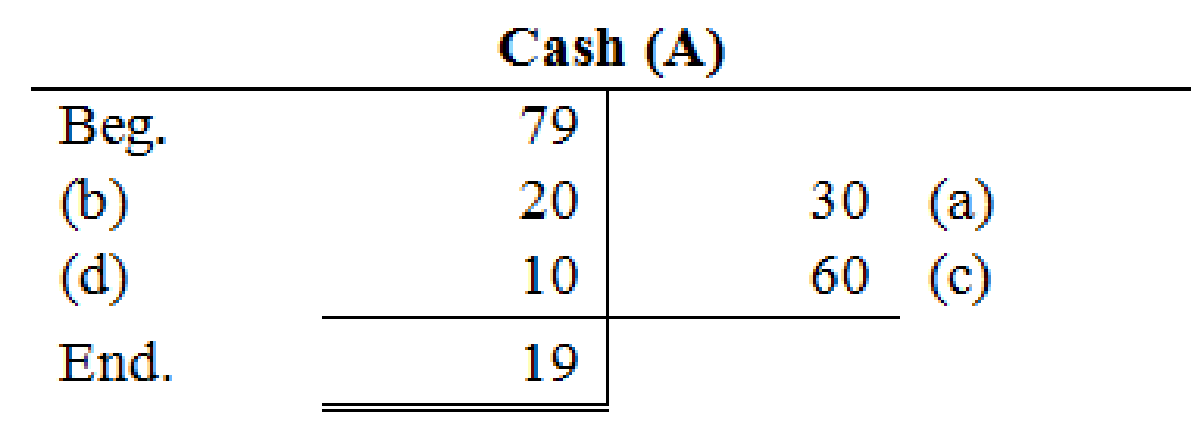
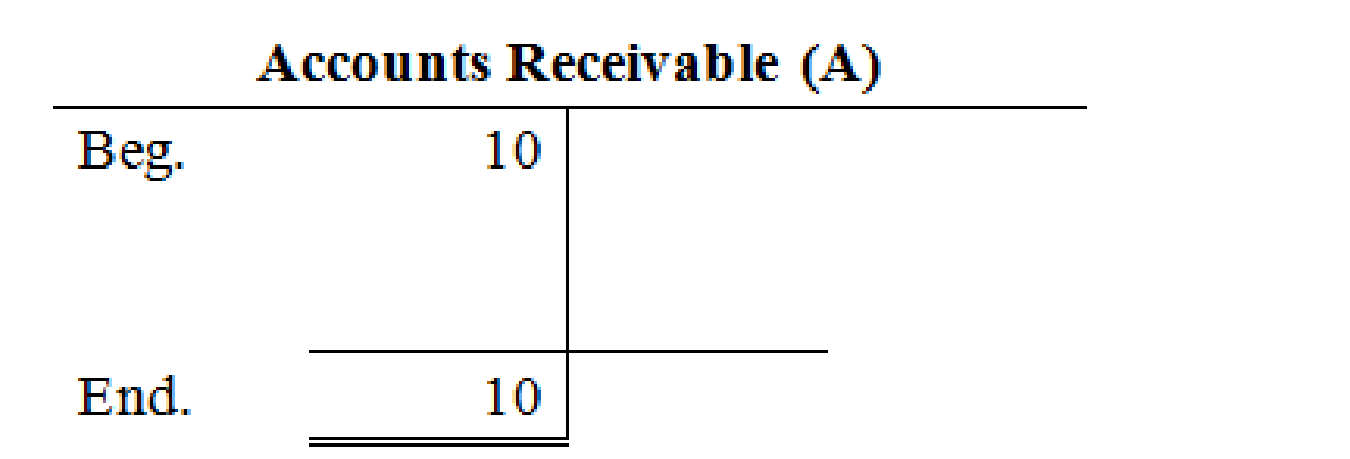
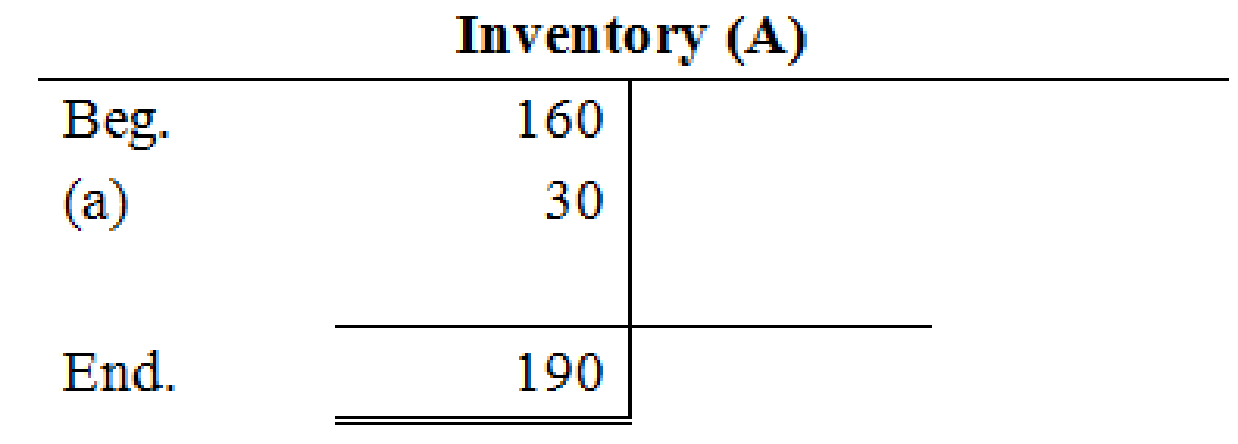




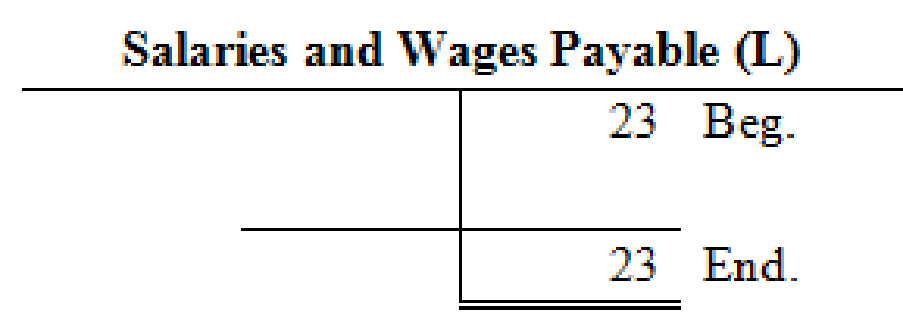



5.
Explain the appropriate response for event (e).
Explanation of Solution
Business transaction: Business transaction is a record of any economic activity, resulting in the change in the value of the assets, the liabilities, and the stockholder’s equities, of a business. Business transaction is also referred to as financial transaction.
Explain the appropriate response for event (e) as follows:
In this case, conducting negotiation to purchase a saw mill is not creating any impact on assets, liabilities and stockholder’s equity of the business, because it is not a business transaction.
6.
Prepare the classified balance sheet of Company E at December 31, 2016.
Explanation of Solution
Classified balance sheet: This is the financial statement of a company which shows the grouping of similar assets and liabilities under subheadings.
Classified balance sheet of Company E is as follows ($ in millions):
| Company E | ||
| Balance sheet | ||
| At December 31, 2016 | ||
| Assets | $(in millions | $(in millions |
| Current Assets: | ||
| Cash | 19 | |
| Accounts Receivable | 10 | |
| Inventory | 190 | |
| Prepaid Rent | 24 | |
| Total Current Assets | 243 | |
| Equipment | 443 | |
| Software | 45 | |
| Total Assets | 731 | |
| Liabilities | ||
| Current Liabilities: | ||
| Accounts Payable | 109 | |
| Salaries and Wages Payable | 23 | |
| Notes Payable (short-term) | 13 | |
| Total Current Liabilities | 145 | |
| Notes Payable (long-term) | 170 | |
| Total Liabilities | 315 | |
| Stockholders’ Equity: | ||
| Common Stock | 396 | |
| Retained Earnings | 20 | |
| Total Stockholders’ Equity | 416 | |
| Total Liabilities and Stockholders’ Equity | 731 | |
Table (1)
Therefore, the total assets of Company E are $731 million, and the total liabilities and stockholders’ equity is $731 million.
7.
Ascertain the current ratio of Company E based on requirement 6 and indicate whether the given transactions has increased or decreased the company’s ability to pay current liabilities.
Explanation of Solution
Ascertain the current ratio of Company E based on requirement 6 and indicate whether the given transactions has increased or decreased the company’s ability to pay current liabilities as follows:
Calculate the current ratio of Company E as follows (refer requirement 6):
Therefore, the current ratio of Company E at December 31, 2016 is 1.68.
Current ratio of Company E at December 31, 2016 (1.68) is less than the current ratio at September 30, 2016 (2.06). It clearly shows that the given transaction has decreased the company’s ability to pay its current liabilities.
8.
Indicate whether the total assets of Company E were primarily financed by liabilities or stockholder’s equity.
Explanation of Solution
Indicate whether the total assets of Company E were primarily financed by liabilities or stockholder’s equity as follows:
The invested amounts of assets primarily come from stockholder’s equity (common stock and retained earnings) of Company E, because stockholder’s equities (common stock) have financed $416 million of Company E’s total assets, whereas liabilities (non-current and current liabilities) have financed only $315 million.
Want to see more full solutions like this?
Chapter 2 Solutions
Fundamentals Of Financial Accounting
- compared to the individual risks of constituting assets. Question 5 (6 marks) The common shares of Almond Beach Inc, have a beta of 0.75, offer a return of 9%, and have an historical standard deviation of return of 17%. Alternatively, the common shares of Palm Beach Inc. have a beta of 1.25, offer a return of 10%, and have an historical standard deviation of return of 13%. Both firms have a marginal tax rate of 37%. The risk-free rate of return is 3% and the expected rate of return on the market portfolio is 9½%. 1. Which company would a well-diversified investor prefer to invest in? Explain why and show all calculations. 2. Which company Would an investor who can invest in the shares of only one firm prefer to invest in? Explain why. RELEASED BY THE CI, MGMT2023, MARCH 2, 2025 5 Use the following template to organize and present your results: Theoretical CAPM Actual offered prediction for expected return (%) return (%) Standard deviation of return (%) Beta Almond Beach Inc. Palm Beach…arrow_forwardprovide correct answerarrow_forwardPlease solve. The screen print is kind of split. Please look carefully.arrow_forward
- Coronado Fire, Inc. manufactures steel cylinders and nozzles for two models of fire extinguishers: (1) a home fire extinguisher and (2) a commercial fire extinguisher. The home model is a high-volume (54,000 units), half-gallon cylinder that holds 2 1/2 pounds of multi- purpose dry chemical at 480 PSI. The commercial model is a low-volume (10,200 units), two-gallon cylinder that holds 10 pounds of multi-purpose dry chemical at 390 PSI. Both products require 1.5 hours of direct labor for completion. Therefore, total annual direct labor hours are 96,300 or [1.5 hours x (54,000+10,200)]. Estimated annual manufacturing overhead is $1,566,090. Thus, the predetermined overhead rate is $16.26 or ($1,566,090 ÷ 96,300) per direct labor hour. The direct materials cost per unit is $18.50 for the home model and $26.50 for the commercial model. The direct labor cost is $19 per unit for both the home and the commercial models. The company's managers identified six activity cost pools and related…arrow_forwardCoronado Fire, Inc. manufactures steel cylinders and nozzles for two models of fire extinguishers: (1) a home fire extinguisher and (2) a commercial fire extinguisher. The home model is a high-volume (54,000 units), half-gallon cylinder that holds 2 1/2 pounds of multi- purpose dry chemical at 480 PSI. The commercial model is a low-volume (10,200 units), two-gallon cylinder that holds 10 pounds of multi-purpose dry chemical at 390 PSI. Both products require 1.5 hours of direct labor for completion. Therefore, total annual direct labor hours are 96,300 or [1.5 hours x (54,000+ 10,200)]. Estimated annual manufacturing overhead is $1,566,090. Thus, the predetermined overhead rate is $16.26 or ($1,566,090 ÷ 96,300) per direct labor hour. The direct materials cost per unit is $18.50 for the home model and $26.50 for the commercial model. The direct labor cost is $19 per unit for both the home and the commercial models. The company's managers identified six activity cost pools and related…arrow_forwardThe completed Payroll Register for the February and March biweekly pay periods is provided, assuming benefits went into effect as anticipated. Required: Using the payroll registers, complete the General Journal entries as follows: February 10 Journalize the employee pay. February 10 Journalize the employer payroll tax for the February 10 pay period. Use 5.4 percent SUTA and 0.6 percent FUTA. No employees will exceed the FUTA or SUTA wage base. February 14 Issue the employee pay. February 24 Journalize the employee pay. February 24 Journalize the employer payroll tax for the February 24 pay period. Use 5.4 percent SUTA and 0.6 percent FUTA. No employee will exceed the FUTA or SUTA wage base. February 28 Issue the employee pay. February 28 Issue payment for the payroll liabilities. March 10 Journalize the employee pay. March 10 Journalize the employer payroll tax for the March 10 pay period. Use 5.4 percent SUTA and 0.6 percent FUTA. No employees will exceed the FUTA or SUTA wage base.…arrow_forward
 Managerial AccountingAccountingISBN:9781337912020Author:Carl Warren, Ph.d. Cma William B. TaylerPublisher:South-Western College Pub
Managerial AccountingAccountingISBN:9781337912020Author:Carl Warren, Ph.d. Cma William B. TaylerPublisher:South-Western College Pub Financial And Managerial AccountingAccountingISBN:9781337902663Author:WARREN, Carl S.Publisher:Cengage Learning,
Financial And Managerial AccountingAccountingISBN:9781337902663Author:WARREN, Carl S.Publisher:Cengage Learning, Financial AccountingAccountingISBN:9781337272124Author:Carl Warren, James M. Reeve, Jonathan DuchacPublisher:Cengage Learning
Financial AccountingAccountingISBN:9781337272124Author:Carl Warren, James M. Reeve, Jonathan DuchacPublisher:Cengage Learning Financial Accounting: The Impact on Decision Make...AccountingISBN:9781305654174Author:Gary A. Porter, Curtis L. NortonPublisher:Cengage LearningPrinciples of Accounting Volume 1AccountingISBN:9781947172685Author:OpenStaxPublisher:OpenStax College
Financial Accounting: The Impact on Decision Make...AccountingISBN:9781305654174Author:Gary A. Porter, Curtis L. NortonPublisher:Cengage LearningPrinciples of Accounting Volume 1AccountingISBN:9781947172685Author:OpenStaxPublisher:OpenStax College





